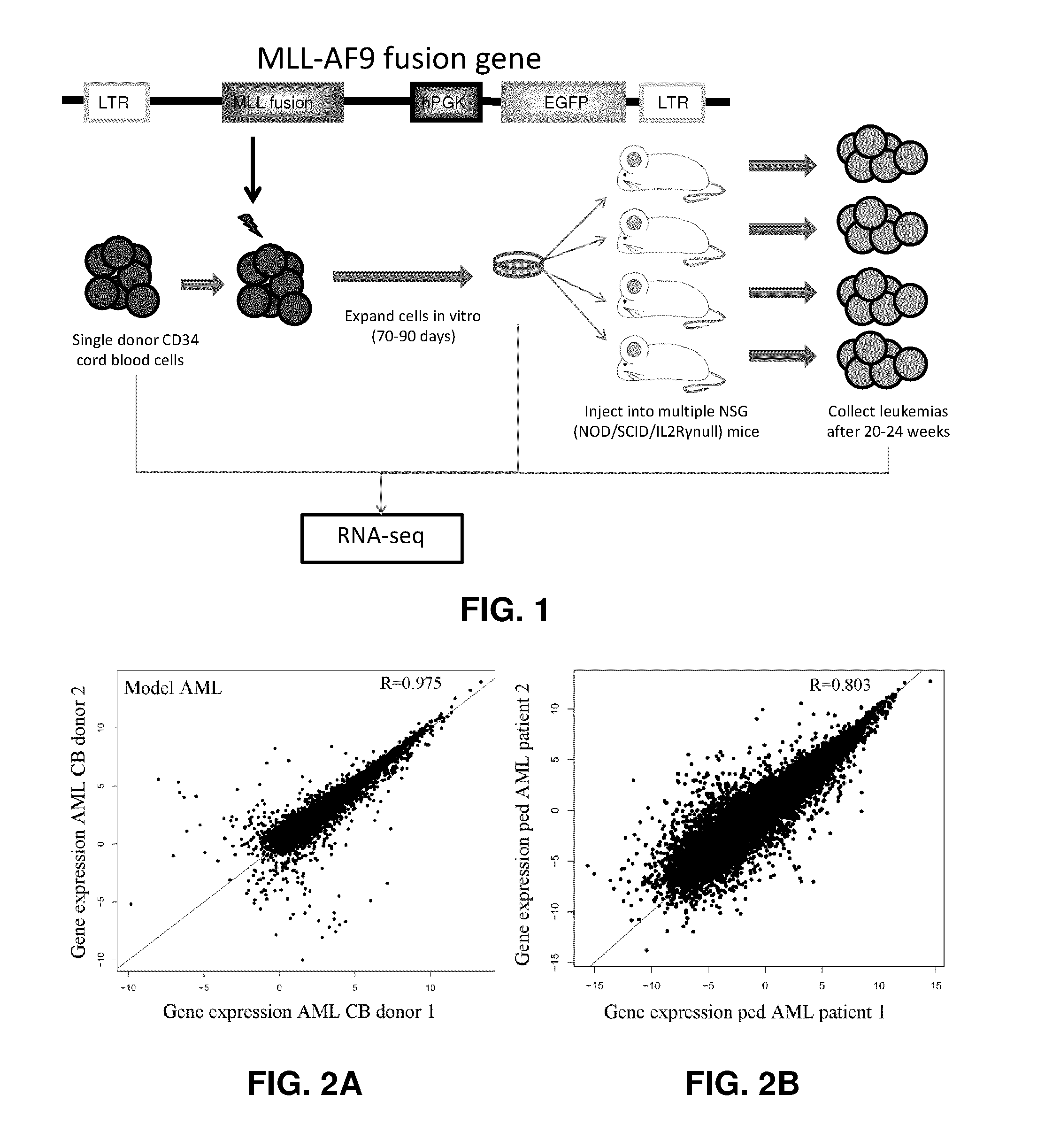Novel biomarkers for acute myeloid leukemia
a myeloid leukemia and biomarker technology, applied in the field of leukemia, can solve the problems of complex genetic heterogeneity of individual patients, and is difficult to use actual patient samples,
- Summary
- Abstract
- Description
- Claims
- Application Information
AI Technical Summary
Benefits of technology
Problems solved by technology
Method used
Image
Examples
example 1
Materials and Methods
Model Leukemias
[0101]Using previously validated methodology, CD34+ enriched CB samples (˜1×106 cells) from single donors (Stem Cell Technologies; STI, Vancouver or isolated in our laboratory) were transduced with a retrovirus containing GFP and the human MA9 fusion gene. Donor cells were split into two fractions: The first (1×105 cells) was used for RNA-seq and exome sequencing in order to identify the mutations present and measure gene expression levels prior to MA9 introduction. The second fraction (0.7×106 cells) was transduced with the fusion gene and expanded in myeloid promoting culture with 15% FSC+IL3+SCF for after 4 weeks of in vitro culture growth. After this time, cells (5×106 / mouse) were injected into multiple NSG immunodeficient mice for each donor sample and separate samples (all of which have been lentivirally transduced) were maintained in culture (80-90 days total) before being collected for RNA sequencing. Mice typically developed leukemias aft...
example 2
Identification and Utility of Candidate Genes as t(9:11) AML Biomarkers
[0105]The data presented in FIGS. 2A and 2B show that the gene expression patterns measured by RNA-seq sequencing are highly reproducible in two AMLs derived from two independent cord blood donors (FIG. 2A) as well as in two pediatric MA9-AML patients.
[0106]Using the approach described above (FIGS. 1 and 3), 39 genes that have characteristics which make them useful as biomarkers for t(9:11) leukemias and in some instances for other potential leukemia types were identified (Table 1). All of these genes have been demonstrated to be expressed in the t(9:11) AML leukemia model as well as multiple pediatric AML samples which also contain the (9:11) translocation. The results depicted in FIGS. 4A-D and Tables 1-2 show that the candidate genes typically exhibit no or low expression in several independent sources of normal tissues, which reduces the risk of adverse diagnostic potential. Importantly, a large sample (>45) ...
PUM
| Property | Measurement | Unit |
|---|---|---|
| Fluorescence | aaaaa | aaaaa |
| Level | aaaaa | aaaaa |
Abstract
Description
Claims
Application Information
 Login to View More
Login to View More - R&D
- Intellectual Property
- Life Sciences
- Materials
- Tech Scout
- Unparalleled Data Quality
- Higher Quality Content
- 60% Fewer Hallucinations
Browse by: Latest US Patents, China's latest patents, Technical Efficacy Thesaurus, Application Domain, Technology Topic, Popular Technical Reports.
© 2025 PatSnap. All rights reserved.Legal|Privacy policy|Modern Slavery Act Transparency Statement|Sitemap|About US| Contact US: help@patsnap.com



